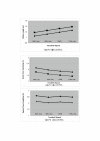Effect of gait speed on gait rhythmicity in Parkinson's disease: variability of stride time and swing time respond differently
- PMID: 16053531
- PMCID: PMC1188069
- DOI: 10.1186/1743-0003-2-23
Effect of gait speed on gait rhythmicity in Parkinson's disease: variability of stride time and swing time respond differently
Abstract
Background: The ability to maintain a steady gait rhythm is impaired in patients with Parkinson's disease (PD). This aspect of locomotor dyscontrol, which likely reflects impaired automaticity in PD, can be quantified by measuring the stride-to-stride variability of gait timing. Previous work has shown an increase in both the variability of the stride time and swing time in PD, but the origins of these changes are not fully understood. Patients with PD also generally walk with a reduced gait speed, a potential confounder of the observed changes in variability. The purpose of the present study was to examine the relationship between walking speed and gait variability.
Methods: Stride time variability and swing time variability were measured in 36 patients with PD (Hoehn and Yahr stage 2-2.5) and 30 healthy controls who walked on a treadmill at four different speeds: 1) Comfortable walking speed (CWS), 2) 80% of CWS 3) 90% of CWS, and 4) 110% of CWS. In addition, we studied the effects of walking slowly on level ground, both with and without a walker.
Results: Consistent with previous findings, increased variability of stride time and swing time was observed in the patients with PD in CWS, compared to controls. In both groups, there was a small but significant association between treadmill gait speed and stride time variability such that higher speeds were associated with lower (better) values of stride time variability (p = 0.0002). In contrast, swing time variability did not change in response to changes in gait speed. Similar results were observed with walking on level ground.
Conclusion: The present results demonstrate that swing time variability is independent of gait speed, at least over the range studied, and therefore, that it may be used as a speed-independent marker of rhythmicity and gait steadiness. Since walking speed did not affect stride time variability and swing time variability in the same way, it appears that these two aspects of gait rhythmicity are not entirely controlled by the same mechanisms. The present findings also suggest that the increased gait variability in PD is disease-related, and not simply a consequence of bradykinesia.
Figures

References
LinkOut - more resources
Full Text Sources

